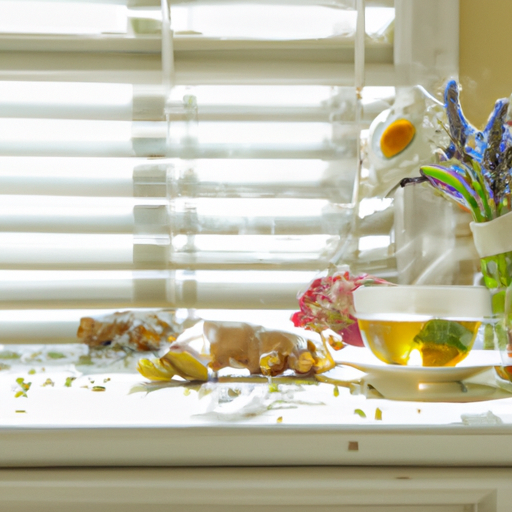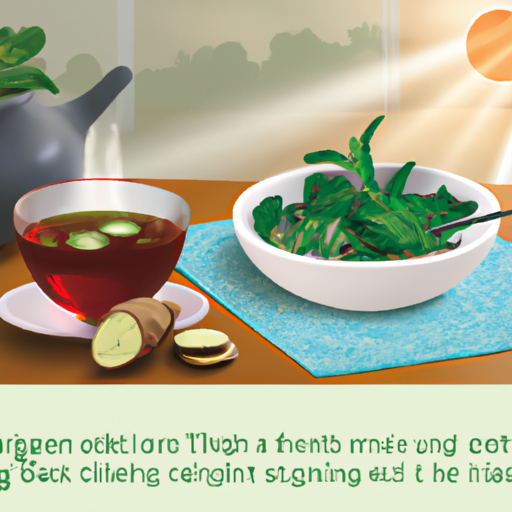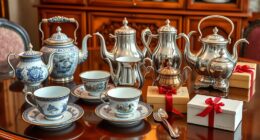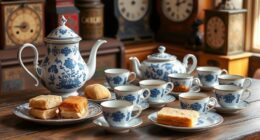Have you been aware that herbal tea has been cherished for centuries because of its many health advantages?
In fact, studies have shown that herbal tea can help boost the immune system, aid digestion, and promote relaxation.
If you’re looking to experience these benefits and enjoy a soothing cup of herbal tea, then you’re in the right place.
In this article, I will guide you through the process of preparing herbal tea right in the comfort of your own home.
With just a few simple ingredients and some basic kitchen tools, you’ll be able to create your own delicious and aromatic blends.
Whether you’re a tea enthusiast or simply looking for a natural way to unwind, making herbal tea at home is a wonderful and fulfilling experience.
So, let’s dive in and discover the art of brewing herbal tea!
Key Takeaways
- Herbal tea can be customized to address specific health concerns and provide various benefits such as immune-boosting, digestion aid, and relaxation promotion.
- The process of preparing herbal tea at home is simple and fulfilling, requiring basic tools like a kettle or pot for boiling water and a teapot or infuser for steeping.
- Different herbs require different water temperatures and steeping times for optimal infusion, so it’s important to follow instructions for each herb.
- Sweeteners and enhancements like lemon, mint, honey, and spices can be added to herbal tea for flavor, and straining the brewed tea is important to remove any loose leaves or particles.
Choose Your Herbal Tea Ingredients
Now it’s time for you to select your favorite herbal tea ingredients and let your taste buds embark on a flavorful adventure!
Herbal tea is not only a soothing and relaxing beverage but also has numerous medicinal properties. It can be a perfect remedy for relaxation and sleep. Using herbal tea for relaxation and sleep has been practiced for centuries, and each ingredient offers unique benefits.
Chamomile, lavender, and valerian root are popular choices for promoting calmness and improving sleep quality. Peppermint and ginger are excellent for soothing an upset stomach and aiding digestion. Elderberry and echinacea are known for their immune-boosting properties.
By exploring the medicinal properties of herbal tea, you can tailor your tea blend to address specific health concerns. For example, if you struggle with anxiety, incorporating herbs like lemon balm and passionflower can provide relief.
Now that you’ve chosen your herbal tea ingredients, it’s time to gather your kitchen tools and start brewing your own delicious and beneficial herbal tea blend.
Gather Your Kitchen Tools
First, make sure you’ve got all the kitchen tools you’ll need to whip up your delicious blend of soothing herbs. Having the right kitchen equipment is essential for brewing the perfect cup of herbal tea. Here are two sub-lists of must-have tools and optional extras to enhance your tea-making experience:
Must-Have Tools:
-
A kettle or pot for boiling water: This is the starting point for any tea-making process. Choose a kettle or pot with a spout for easy pouring.
-
A teapot or infuser: To steep your herbs properly, you’ll need a teapot or infuser. Opt for a teapot with a built-in strainer or an infuser that fits inside your cup.
Optional Extras:
-
A tea thermometer: For precise brewing, a thermometer can help you maintain the ideal water temperature.
-
A tea timer: To ensure you steep your herbs for the perfect length of time, consider using a tea timer.
Now that you have all the necessary tools, it’s time to move on to the next step: boiling water and infusing the herbs.
Boil Water and Infuse the Herbs
To begin boiling water and infusing the herbs, simply fill your kettle or pot with water and bring it to a gentle simmer. This step is crucial as it helps release the flavors and medicinal properties of the herbs. While boiling water may seem like a basic task, it is important to note that different herbs require different water temperatures for optimal infusion. To ensure you achieve the desired results, refer to the table below for infusing techniques and recommended water temperatures.
| Herb | Water Temperature | Infusing Time |
|---|---|---|
| Chamomile | 200°F (93°C) | 5 minutes |
| Peppermint | 212°F (100°C) | 3-5 minutes |
| Ginger | 212°F (100°C) | 5-7 minutes |
Infusing techniques involve allowing the herbs to steep in the hot water for a specific time. This allows the water to absorb the flavors, aromas, and health benefits of the herbs. After infusing, strain the tea to remove any solid particles before enjoying a soothing cup of herbal tea. Now that the water is infused with the wonderful properties of the herbs, it’s time to move on to the next step: adding sweeteners or enhancements (optional).
Add Sweeteners or Enhancements (Optional)
Transform your cup of herbal infusion into a delightful elixir by adding a touch of sweetness or an enchanting enhancement, turning an ordinary moment into a magical experience.
When it comes to flavor combinations, the possibilities are endless. Experiment with different herbs and spices to create unique and delicious blends. Some popular options include adding a slice of lemon or a few sprigs of fresh mint for a refreshing twist. If you prefer a sweeter taste, consider using natural sweeteners like honey, maple syrup, or stevia. These options not only add sweetness but also lend their own distinct flavors, enhancing the overall taste of your herbal tea.
For a floral and fragrant note, try adding a splash of rose water or a sprinkle of lavender buds. These additions can transport you to a serene garden and provide a calming effect. If you’re feeling adventurous, consider adding a pinch of cinnamon, a dash of ginger, or a hint of cardamom for a warming and spicy kick. These spices not only add depth to the flavor but also offer various health benefits.
As you explore different flavor combinations and natural sweeteners, remember to keep the overall balance in mind. You want the sweeteners and enhancements to complement the herbal tea, not overpower it.
Once you have added your desired sweeteners or enhancements, it’s time to move on to the next step: strain and serve, allowing the flavors to meld and create a truly satisfying cup of herbal tea.
Strain and Serve
Once you’ve infused your blend to perfection, it’s time to strain and serve, unlocking the full potential of your magical elixir. Straining your herbal tea is an important step to remove any loose leaves or particles, ensuring a smooth and enjoyable drinking experience.
Here are three essential tea brewing techniques to help you strain and serve your herbal tea like a pro:
-
Use a fine mesh strainer: Place the strainer over your teacup or teapot and carefully pour the brewed tea through it. The fine mesh will catch any small particles, leaving you with a clean and clear cup of tea.
-
Opt for a tea infuser: If you prefer a more convenient option, use a tea infuser. Fill the infuser with your brewed tea and let it steep for a few minutes. Then, simply remove the infuser and discard the tea leaves, leaving you with a perfectly brewed cup of herbal tea.
-
Try a teapot with a built-in strainer: Some teapots come with built-in strainers, making the straining process even easier. Simply pour your brewed tea into the teapot, and the strainer will catch any loose leaves, giving you a hassle-free serving experience.
Not only is herbal tea delicious, but it also offers numerous health benefits. It can help boost your immune system, aid digestion, and promote relaxation.
Now that you know how to strain and serve your herbal tea, it’s time to move on to the next exciting step: experimenting with flavors and blends, taking your tea experience to new heights.
Experiment with Flavors and Blends
Discovering new and exciting flavors and blends is the key to elevating your tea experience and unlocking a world of taste sensations. When it comes to herbal tea, the possibilities are endless. By experimenting with different flavors and blends, you can create unique and personalized concoctions that suit your taste preferences and offer a range of health benefits.
To get started, let your creativity flow and try out creative combinations of herbs, spices, and fruits. For example, you could blend chamomile with lavender for a calming and soothing tea, or mix mint with lemon and ginger for a refreshing and invigorating brew. Don’t be afraid to think outside the box and combine unexpected ingredients to create exotic infusions that tantalize your taste buds.
To help you on your flavor journey, here is a table showcasing some popular herbal tea combinations:
| Base Herb | Enhancing Flavor | Additional Benefits |
|---|---|---|
| Chamomile | Lavender | Calming and soothing |
| Mint | Lemon and ginger | Refreshing and invigorating |
| Rooibos | Vanilla | Antioxidant-rich |
| Hibiscus | Rosehip | Vitamin C boost |
| Ginger | Turmeric | Anti-inflammatory |
By exploring these creative combinations and experimenting with different flavors and blends, you can craft herbal teas that not only taste delightful but also offer a range of health benefits. So go ahead, embark on your flavor adventure and enjoy the benefits of homemade herbal tea that is tailored to your preferences and needs.
Enjoy the Benefits of Homemade Herbal Tea
As someone who enjoys preparing herbal tea at home, I can attest to the many benefits it provides. Not only does herbal tea offer relaxation and stress relief, but it also supports digestive health and boosts the immune system.
By incorporating homemade herbal tea into my daily routine, I’ve found a natural and effective way to promote overall well-being.
Relaxation and Stress Relief
To achieve ultimate relaxation and stress relief, whip up a soothing cup of herbal tea at home. It’s a simple and effective way to promote mental well-being and find solace in natural remedies.
Here are three tips to help you fully enjoy the benefits of homemade herbal tea:
-
Choose the right herbs: Look for herbs like chamomile, lavender, and lemon balm, which are known for their calming properties and can help reduce stress and anxiety.
-
Steep with care: Follow the instructions for each herb to ensure you extract the maximum flavor and health benefits. Steeping times can vary, so be mindful of the recommended duration.
-
Create a serene ambiance: Find a peaceful spot in your home, sip your tea slowly, and take deep breaths. Allow yourself to unwind and let go of any tension.
By incorporating these practices into your tea routine, you can pave the way for a calm and serene mind.
Transitioning into the next section, let’s explore how herbal tea can support digestive health and boost the immune system.
Digestive Health and Immune Support
Enhance your digestive health and boost your immune system by incorporating the healing properties of herbal tea into your daily routine. Herbal teas have been used for centuries to support digestive health and promote a strong immune system. They are packed with beneficial compounds like antioxidants, vitamins, and minerals that help improve digestion and strengthen the immune system. Some herbal teas, such as peppermint and ginger, can soothe an upset stomach and relieve indigestion. Others, like chamomile and echinacea, have immune-boosting properties that help the body fight off infections. By regularly enjoying a cup of herbal tea, you can support your digestive health and fortify your immune system, helping you maintain overall wellness.
| Herbal Tea | Benefits |
|---|---|
| Peppermint | Soothes an upset stomach |
| Ginger | Relieves indigestion |
| Chamomile | Calms digestive system |
| Echinacea | Boosts immune system |
Frequently Asked Questions
Can I use fresh herbs instead of dried herbs for making herbal tea?
Yes, fresh herbs can be used for making herbal tea. However, using dried herbs is often preferred for medicinal purposes. Dried herbs have concentrated flavors and longer shelf life, making them more beneficial for making herbal tea.
How long does it take for the water to boil before infusing the herbs?
To properly infuse herbs in boiling water, it typically takes 5-10 minutes. The infusion time can vary depending on the type of herb used. For example, delicate herbs like chamomile may only need 5 minutes, while stronger herbs like rosemary may require 10 minutes.
Are there any specific kitchen tools that I need to prepare herbal tea?
To prepare herbal tea at home, you can use alternative kitchen tools such as a French press or a tea infuser. Additionally, there are different methods of brewing herbal tea, including steeping loose herbs or using tea bags.
Can I use honey as a sweetener for my herbal tea?
Absolutely! Honey is a fabulous sweetener for herbal tea. Not only does it add a touch of natural sweetness, but it also offers numerous health benefits. If you’re looking for alternatives, try agave or stevia.
What are some common herbal tea blends and their benefits?
Different ways to incorporate herbal tea blends into your daily routine include enjoying a cup in the morning or as an afternoon pick-me-up. Herbal tea blends have a rich history and cultural significance, offering various benefits for overall well-being.
Conclusion
In conclusion, crafting your own herbal tea at home is a delightful journey of flavors and aromas. It allows you to delight in the art of infusing nature’s goodness into a comforting beverage.
By exploring different blends and experimenting with enhancements, you can create a symphony of taste that tantalizes your senses. Taking a sip of this homemade elixir transports you to a serene garden, where the fragrant herbs dance on your palate.
Embrace the benefits and pleasures of homemade herbal tea and elevate your tea-drinking experience to new heights.










